Programmatic direct offers guaranteed ad placements and premium inventory through negotiated deals, ensuring brand safety and predictable outcomes. Open auction operates on a real-time bidding system where multiple advertisers compete for impressions, often resulting in lower costs but less predictability. Choosing between programmatic direct and open auction depends on a campaign's need for control versus scalability in digital media advertising.
Table of Comparison
| Feature | Programmatic Direct | Open Auction |
|---|---|---|
| Definition | Automated guaranteed buying of premium ad inventory | Real-time bidding for ad inventory in an open marketplace |
| Inventory Quality | Premium, predefined inventory | Varied, wide-ranging inventory |
| Pricing Model | Fixed CPM (Cost Per Mille) | Dynamic CPM via real-time bidding |
| Transparency | High, direct deals with publishers | Lower, multiple intermediaries involved |
| Control | Buyers select inventory and audience directly | Less direct control, bid-based targeting |
| Speed | Slower setup, longer campaign cycles | Instantaneous bidding and ad delivery |
| Use Case | Brand safety, guaranteed reach, premium campaigns | Performance-driven, cost-efficient campaigns |
Introduction to Programmatic Direct and Open Auction
Programmatic Direct enables advertisers to buy guaranteed, premium ad inventory through automated deals with publishers, ensuring brand safety and predictable placements. Open Auction allows multiple advertisers to bid in real-time for ad space, maximizing competition and enabling cost-efficiency across diverse inventory. Both methods leverage real-time bidding technology but differ in transparency, control, and inventory access within the digital advertising ecosystem.
Key Differences Between Programmatic Direct and Open Auction
Programmatic Direct offers guaranteed inventory at fixed prices, providing brands with premium ad placements and predictable campaign outcomes, while Open Auction operates on a real-time bidding model where multiple advertisers compete for impressions, often leading to variable costs and ad placements. Programmatic Direct ensures transparency and control over where ads appear, reducing fraud and brand safety risks compared to the Open Auction's automated, algorithm-driven environment. Advertisers favor Programmatic Direct for strategic campaigns requiring precision, whereas Open Auction suits dynamic budgets and broader reach through auction-based demand.
Benefits of Programmatic Direct for Advertisers
Programmatic Direct offers advertisers guaranteed ad placements with premium inventory, enhancing brand safety and viewability compared to Open Auction. It enables precise targeting and predictable pricing, reducing the risks of bid competition and ad fraud commonly associated with open marketplaces. This controlled environment facilitates stronger relationships with publishers, improving campaign performance and ROI for advertisers.
Advantages of Open Auction in Digital Media
Open auction in digital media offers greater inventory access and competitive pricing by allowing multiple buyers to bid in real-time, maximizing ad revenue potential. This transparent, automated marketplace enhances campaign efficiency through real-time bidding and data-driven targeting, improving audience reach and cost-effectiveness. Advertisers benefit from flexibility and scalability, enabling rapid adjustments to bidding strategies based on performance insights across diverse inventory sources.
Targeting Capabilities: Programmatic Direct vs Open Auction
Programmatic Direct offers advanced targeting capabilities by enabling advertisers to secure premium inventory with guaranteed impressions, allowing precise audience segmentation through first-party data and defined parameters. Open Auction relies on real-time bidding, providing broader access but less control over audience targeting, which may result in less specific ad placements. This makes Programmatic Direct ideal for campaigns requiring exact demographic or contextual targeting, while Open Auction suits broader reach objectives with flexible budget options.
Transparency and Brand Safety Considerations
Programmatic direct offers greater transparency by enabling advertisers to negotiate fixed terms and secure premium inventory, reducing risks associated with fraud and brand safety. Open auction operates on real-time bidding, which can increase exposure but may compromise transparency and pose challenges in controlling ad placements. Ensuring brand safety often requires advanced verification tools and partnerships with trusted supply sources in both programmatic direct and open auction environments.
Pricing Models and Cost Efficiency
Programmatic direct offers fixed pricing models that ensure predictable costs and premium inventory access, making it ideal for advertisers seeking guaranteed impressions and brand safety. Open auction uses a real-time bidding system where prices fluctuate based on demand, often resulting in cost efficiencies but with less predictability. Advertisers balancing budget control and targeting precision typically weigh programmatic direct's higher upfront costs against the variable but potentially lower expenses of open auction environments.
Inventory Quality and Availability
Programmatic direct offers premium inventory quality with guaranteed ad placements on high-value sites, ensuring brand safety and consistent reach. Open auction provides access to a vast pool of inventory with variable quality and availability, often resulting in lower costs but less predictability. Advertisers prioritize programmatic direct for consistent exposure, while open auction maximizes scale and flexibility in digital media buying.
Use Cases: When to Choose Programmatic Direct or Open Auction
Programmatic Direct is ideal for premium brand campaigns requiring guaranteed ad placements and precise audience targeting, such as exclusive product launches or high-value partnerships. Open Auction suits performance-driven campaigns that prioritize reach and cost-efficiency, like retargeting or testing new creatives across diverse inventory. Marketers select Programmatic Direct for control and quality, while Open Auction thrives on scalability and dynamic bidding optimization.
Future Trends in Programmatic Advertising
Programmatic direct offers guaranteed inventory and premium placements, appealing to brands focused on brand safety and transparency, while open auction prioritizes scale and real-time bidding efficiency. Future trends in programmatic advertising emphasize increased automation with AI-driven optimization, enhanced data privacy compliance through contextual targeting, and the integration of connected TV (CTV) and addressable TV to reach audiences across multiple screens. Advances in machine learning will enable more precise audience segmentation, boosting campaign performance and return on ad spend (ROAS) in both programmatic direct and open auction environments.
Programmatic direct vs Open auction Infographic

 techiny.com
techiny.com